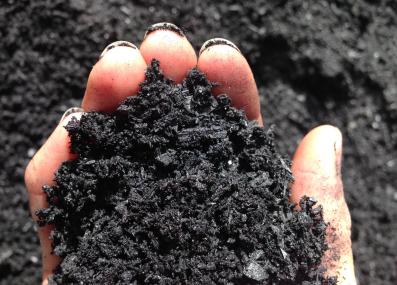New to Climate Change?
Soil-Based Carbon Sequestration
Soils are made in part of broken-down plant matter.1 This means they contain a lot of carbon that those plants took in from the atmosphere while they were alive. Especially in colder climates where decomposition is slow, soils can store—or “sequester”—this carbon for a very long time. If not for soil, this carbon would return to the atmosphere as carbon dioxide (CO2), the main greenhouse gas causing climate change.
But converting natural ecosystems like forests and grasslands to farmland disturbs soil structure, releasing much of that stored carbon and contributing to climate change. Over the past 12,000 years, the growth of farmland has released about 110 billion metric tons of carbon from the top layer of soil2—roughly equivalent to 80 years’ worth of present-day U.S. emissions.3 The question is: Can this trend be reversed at the global scale as part of a strategy to help fight climate change?
Storing carbon in agricultural soils
Scientists have estimated that soils—mostly, agricultural ones—could sequester over a billion additional tons of carbon each year.4 This has led policymakers to increasingly look to soil-based carbon sequestration as a “negative emissions” technology—that is, one that removes CO2 from the air and stores it somewhere it can’t easily escape.5
Cropland, which takes up 10% of the Earth’s land, is a major target for soil-based carbon sequestration. Farmers can add more carbon to agricultural soils by planting certain kinds of crops. For example, perennial crops, which do not die off every year, grow deep roots that help soils store more carbon. “Cover crops” like clover, beans and peas, planted after the main crop is harvested, help soils take in carbon year-round, and can be plowed under the ground as “green manure” that adds more carbon to the soil. Farmers can also do less intensive tilling. By breaking up the soil, tilling prepares land for new crops and helps control weeds, but also releases a lot of stored carbon.
Proponents argue that farming practices that store more carbon can also improve soil health and food production.6
Limitations of soil-based carbon storage
There are hundreds of millions of farmers around the world, mostly farming small plots of land. To take full advantage of soil-based sequestration as a climate solution, we would need many of them to change the way they farm, now and for hundreds of years in the future. This is a big social and economic challenge, and experts debate how much soil-based sequestration is really possible over the long term.7-9
Climate change is also making it harder for soils to naturally store carbon. The warming of the planet could lead to widespread soil carbon losses by speeding up the decay of soil organic matter. We are already seeing this happen in the Arctic as permafrost, or permanently frozen soil, thaws. This release of CO2 to the atmosphere could become a self-reinforcing feedback loop, where lost soil carbon warms the Earth, causing soils to release even more carbon.10
Ultimately, scientists say soil-based carbon sequestration, like other negative emissions technologies, can help fight climate change, but cannot take carbon out of the atmosphere as fast as we are currently adding it. To stop global warming, these efforts to store carbon must be coupled with drastic cuts in greenhouse gas emissions.11
Published April 15, 2021.
1 Most of the soil mass is not plant matter—it is inorganic material like sand, silt and clay. Soil organic carbon tends to be concentrated in the topsoil. Some soils, like those in many deserts, have very little carbon—less than 0.5%. Other soils, like in wetlands or peat forests, may be 10% carbon or more.
2 J. Sanderman, T. Hengl, and Gregory J. Fiske. "Soil carbon debt of 12,000 years of human land use." Proceedings of the National Academy of Sciences 114 (36) 9575-9580, 2017, doi:.
3 “U.S. Energy-Related Carbon Dioxide Fell by 2.8% in 2019, Slightly below 2017 Levels.” Independent Statistics and Analysis - U.S. Energy Information Administration (EIA), 5 May 2020.
4 K. Paustain, E. Larson, J. Kent, E. Marx and A. Swan. "Soil C Sequestration as a biological negative emission strategy." Frontiers in Climate 16, 2019, doi:10.3389/fclim.2019.00008.
5 National Academies of Sciences, Engineering, and Medicine. 2019. Negative Emissions Technologies and Reliable Sequestration: A Research Agenda. Washington, DC: The National Academies Press. doi:10.17226/25259
6 D.A. Bassio, S.C. Cook-Patton, P.W. Ellis, J. Fargione, J. Sanderman, et al. 2020. "The role of soil carbon in natural climate solutions." Nature Sustainability 3, 391–398, 2020, doi:10.1038/s41893-020-0491-z
7 P. Smith, O. Andren, T. Karlsson, P. Perala, K. Regina, M. Rounsevell, B. van Wesemael. "Carbon sequestration potential in European croplands has been overestimated." Global Change Biology 11, 2153-2163, 2005, doi:10.1111/j.1365-2486.2005.01052.x
8 U. Stockmann, M.A. Adams, J.W. Crawford, D.J. Field, N. Henakaarchchi et al. "The knowns, known unknowns and unknowns of sequestration of soil organic carbon." Agriculture, Ecosystems, and Environment. 164 80-99, 2013, doi:10.1016/j.agee.2012.10.001
9 T. Searchinger. "Menu item: focus on realistic options to sequester carbon in agricultural soils." Creating a Sustainable Food Future. Chapter 30, 375-385. World Resources Institute, 2019.
10 M.S. Patzner, et al. “Iron mineral dissolution releases iron and associated organic carbon during permafrost thaw.” Nature Communications, vol. 11, 2020, doi:10.1038/s41467-020-20102-6
11 J.M. Melillo, S.D. Frey, K.M. DeAngelis, W. Werner, M.J. Bernard, F.P. Bowles, G. Pold, M.A. Knorr, A.S. Grandy. "Long-term pattern and magnitude of soil carbon feedback to the climate system in a warming world." Science. 358:101-105, 2017, doi:10.1126/science.aan2874










